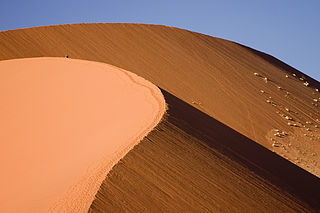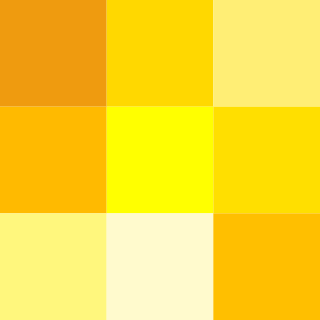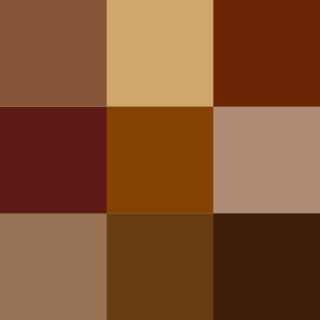
Brown is a shade. It can be considered a composite color, but it is mainly a darker shade of orange. In the CMYK color model used in printing and painting, brown is usually made by combining the colors orange and black.

A pigment is a powder used to add color or change visual appearance. Pigments are completely or nearly insoluble and chemically unreactive in water or another medium; in contrast, dyes are colored substances which are soluble or go into solution at some stage in their use. Dyes are often organic compounds whereas pigments are often inorganic. Pigments of prehistoric and historic value include ochre, charcoal, and lapis lazuli.

Limonite is an iron ore consisting of a mixture of hydrated iron(III) oxide-hydroxides in varying composition. The generic formula is frequently written as FeO(OH)·nH2O, although this is not entirely accurate as the ratio of oxide to hydroxide can vary quite widely. Limonite is one of the three principal iron ores, the others being hematite and magnetite, and has been mined for the production of iron since at least 400 BC.

Ochre, iron ochre, or ocher in American English, is a natural clay earth pigment, a mixture of ferric oxide and varying amounts of clay and sand. It ranges in colour from yellow to deep orange or brown. It is also the name of the colours produced by this pigment, especially a light brownish-yellow. A variant of ochre containing a large amount of hematite, or dehydrated iron oxide, has a reddish tint known as red ochre.

Umber is a natural earth pigment consisting of iron oxide and manganese oxide; it has a brownish color that can vary among shades of yellow, red, and green. Umber is considered one of the oldest pigments known to humans, first seen in Ajanta Caves in 200 BC – 600 AD. Umber's advantages are its highly versatile color, warm tone, and quick drying abilities. While some sources indicate that umber's name comes from its geographic origin in Umbria, other scholars suggest that it derives from the Latin word umbra, which means "shadow". The belief that its name derives from the word for shadow is fitting, as the color helps create shadows. The color is primarily produced in Cyprus. Umber is typically mined from open pits or underground mines and ground into a fine powder that is washed to remove impurities. In the 20th century, the rise of synthetic dyes decreased the demand for natural pigments such as umber.

Earth pigments are naturally occurring minerals that have been used since prehistoric times as pigments. Among the primary types of earth pigments include the reddish-brown ochres, siennas, and umbers, which contain various amounts of iron oxides and manganese oxides. Other earth pigments include the green earth pigments or terres vertes, blue earth pigments such as vivianite-based "blue ochre", white earth pigments such as chalk, and black earth pigments such as charcoal.

Beige is variously described as a pale sandy fawn color, a grayish tan, a light-grayish yellowish brown, or a pale to grayish yellow. It takes its name from French, where the word originally meant natural wool that has been neither bleached nor dyed, hence also the color of natural wool.
Payne's grey is a dark blue-grey colour used in painting. Originally a mixture of iron blue, yellow ochre and crimson lake, Payne's grey now is often a mixture of blue and black, or of ultramarine and burnt sienna. The colour is named after William Payne, who painted watercolours in the late 18th century, who most likely developed the colour while trying to produce a mixer that was less intense than black. Payne's grey was deemed an obsolete term in the early 19th century, but is still used by artists today.
Taupe is a dark gray-brown color. The word derives from the French noun taupe meaning "mole". The name originally referred only to the average color of the French mole, but beginning in the 1940s, its usage expanded to encompass a wider range of shades.

Bole is a shade of reddish brown. The color term derives from Latin bōlus and refers to a kind of soft fine clay whose reddish-brown varieties are used as pigments, and as a coating in panel paintings and frames underneath the paint or gold leaf. Under gold leaf, it "warms" the colour, which can have a greenish shade otherwise. However, bole in art is a good deal more red and less brown than the modern shade; it is often called Armenian bole. Although bole also means the trunk of a tree, these words are simply homographs that do not share an etymological origin.

Varieties of the color green may differ in hue, chroma or lightness, or in two or three of these qualities. Variations in value are also called tints and shades, a tint being a green or other hue mixed with white, a shade being mixed with black. A large selection of these various colors is shown below.

Varieties of the color red may differ in hue, chroma, lightness, or in two or three of these qualities. Variations in value are also called tints and shades, a tint being a red or other hue mixed with white, a shade being mixed with black. A large selection of these various colors are shown below.

Desert sand is a very light and very weakly saturated reddish yellow colour which corresponds specifically to the coloration of sand. It may also be regarded as a deep tone of beige.

Varieties of the color yellow may differ in hue, chroma or lightness, or in two or three of these qualities. Variations in value are also called tints and shades, a tint being a yellow or other hue mixed with white, a shade being mixed with black. A large selection of these various colors is shown below.
Stil de grain yellow or sap green is a pigment derived from berries of the buckthorn species Rhamnus saxatilis, which are commonly called Avignon berries or Persian berries after two historical areas of supply; latterly Italy was a major source. The color, whose principal chemical component is rhamnetin, was formerly called pink ; latterly, to distinguish it from light red "pink", the yellow "pink" was qualified as Dutch pink, brown pink, English pink, Italian pink, or French pink — the first three also applied to similar quercitron dyes from the American eastern black oak, Quercus velutina. Other names are Persian berries lake, yellow berries and buckthorn berries.

Shades of brown can be produced by combining red, yellow, and black pigments, or by a combination of orange and black—illustrated in the color box. The RGB color model, that generates all colors on computer and television screens, makes brown by combining red and green light at different intensities. Brown color names are often imprecise, and some shades, such as beige, can refer to lighter rather than darker shades of yellow and red. Such colors are less saturated than colors perceived to be orange. Browns are usually described as light or dark, reddish, yellowish, or gray-brown. There are no standardized names for shades of brown; the same shade may have different names on different color lists, and sometimes one name can refer to several very different colors. The X11 color list of web colors has seventeen different shades of brown, but the complete list of browns is much longer.

Shades of black, or off-black colors, are colors that differ only slightly from pure black. These colors have a low lightness. From a photometric point of view, a color which differs slightly from black always has low relative luminance. Colors often considered "shades of black" include onyx, black olive, charcoal, and jet.

Iron oxide red is a generic name of a ferric oxide pigment of reddish colors. Multiple shades based on both anhydrous Fe
2O
3 and its hydrates were known to painters since prehistory. The pigments were originally obtained from natural sources, since the 20th century they are mostly synthetic. These substances form one of the most commercially important groups of pigments, and their names sometimes reflect the location of a natural source, later transferred to the synthetic analog. Well-known examples include the Persian Gulf Oxide with 75% Fe
2O
3 and 25% silica, Spanish red with 85% of oxide, Tuscan red.
Van Dyke (Vandyke) brown, also known as Cassel earth or Cologne earth, is a deep, rich, and warm brown colour often used in painting and printmaking. Early publications on the pigment refer to it as Cassel earth or Cologne earth in reference to its city of origin; however, today it is typically called Van Dyke brown after the painter Anthony van Dyck.














